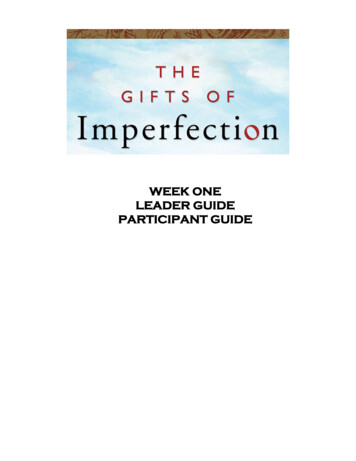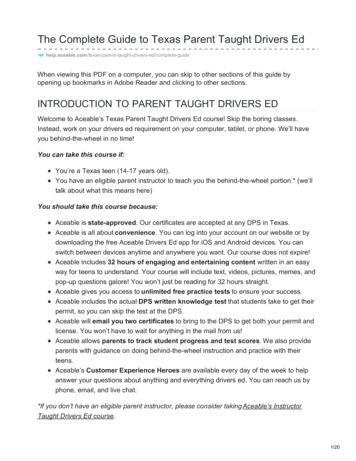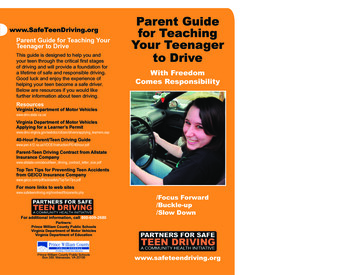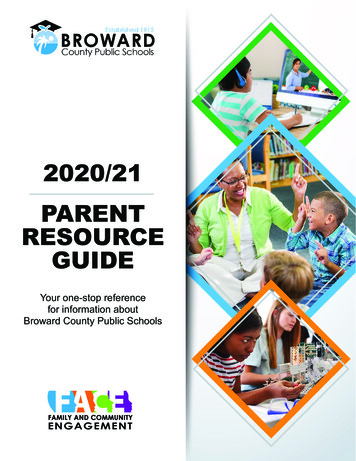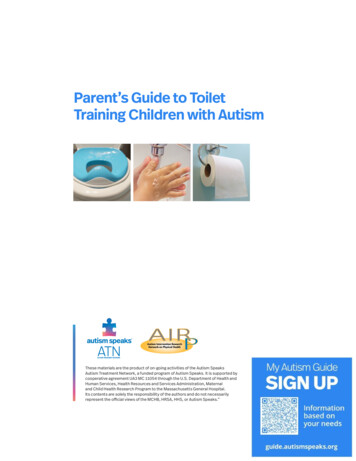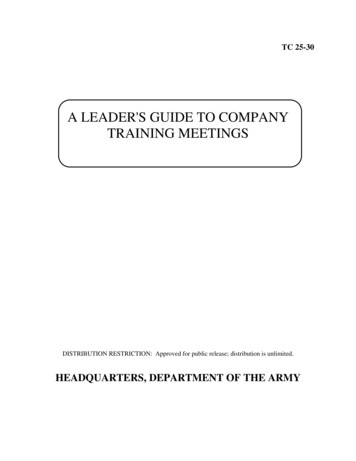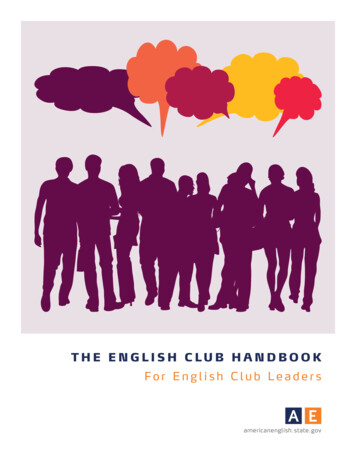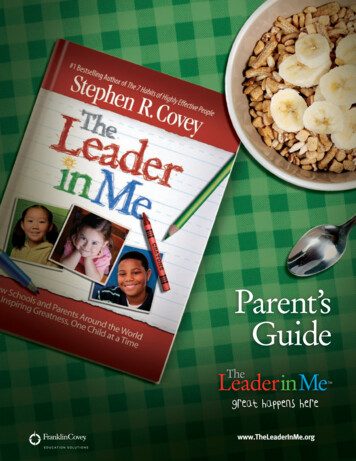
Transcription
Parent’sGuidewww.TheLeaderInMe.org
Parent’s GuideTable of ContentsWelcome. . . . . . . . . . . . . . . . . . . . . . . . . . . . . . . . . . . . . . . . . . . . . . . . . . . . . . . . . . . . . . . . . . . . 2Go at the Right Pace. . . . . . . . . . . . . . . . . . . . . . . . . . . . . . . . . . . . . . . . . . . . . . . . . . . . . 2Keep It Simple. . . . . . . . . . . . . . . . . . . . . . . . . . . . . . . . . . . . . . . . . . . . . . . . . . . . . . . . . . . 2Learn More About the 7 Habits . . . . . . . . . . . . . . . . . . . . . . . . . . . . . . . . . . . . . . . . . . . 2Parent-Child Activities . . . . . . . . . . . . . . . . . . . . . . . . . . . . . . . . . . . . . . . . . . . . . . . . . . . . . . . 3Habit 1: Be Proactive . . . . . . . . . . . . . . . . . . . . . . . . . . . . . . . . . . . . . . . . . . . . . . . . . . . . 4 Habit 2: Begin With the End in MindHabit 3: Put First Things FirstHabit 4: Think Win-Win . . . . . . . . . . . . . . . . . . . . . . . . . . . . . . . . . . . . 6 . . . . . . . . . . . . . . . . . . . . . . . . . . . . . . . . . . . . . . . . . . .8. . . . . . . . . . . . . . . . . . . . . . . . . . . . . . . . . . . . . . . . . . . . . . . .9 Habit 5: Seek First to Understand, Then to Be Understood . . . . . . . . . . . . . . . .10Habit 6: Synergize . . . . . . . . . . . . . . . . . . . . . . . . . . . . . . . . . . . . . . . . . . . . . . . . . . . . . . . 11 Habit 7: Sharpen the Saw . . . . . . . . . . . . . . . . . . . . . . . . . . . . . . . . . . . . . . . . . . . . . . . .12Additional Resources . . . . . . . . . . . . . . . . . . . . . . . . . . . . . . . . . . . . . . . . . . . . . . . . . . . . . . . . 13Web Resources . . . . . . . . . . . . . . . . . . . . . . . . . . . . . . . . . . . . . . . . . . . . . . . . . . . . . . . . . . 13Parent Book List. . . . . . . . . . . . . . . . . . . . . . . . . . . . . . . . . . . . . . . . . . . . . . . . . . . . . . . . . 13Primary-Age Children’s Reading List. . . . . . . . . . . . . . . . . . . . . . . . . . . . . . . . . . . . . . . 14Upper-Age Children’s Reading List . . . . . . . . . . . . . . . . . . . . . . . . . . . . . . . . . . . . . . . . 17Teen Reading List. . . . . . . . . . . . . . . . . . . . . . . . . . . . . . . . . . . . . . . . . . . . . . . . . . . . . . . . 20Sponsorship. . . . . . . . . . . . . . . . . . . . . . . . . . . . . . . . . . . . . . . . . . . . . . . . . . . . . . . . . . . . . . . . 21 FranklinCovey. All rights reserved. Printed in the United States of America. No part of this publication may be reproduced or transmitted in any form or by any means, electronicor mechanical, including photocopying, recording, or using any information-storage or retrieval system, for any purpose without the express written permission of FranklinCovey.Registered and/or pending trademarks of FranklinCovey in the United States andf oreign countries are used throughout this work. Use of the trademark symbols“ ” or “ ” .is limited to one or two prominent trademark usages for each mark.Trademarks understood to be owned by others are used in a nontrademark mannerfor explanatory purposes only, or ownership by others is indicated to the extent known.All persons, companies, and organizations listed in examples and case studies herein are purely fictitious for teaching purposes, unless the example expressly states otherwise. .Any resemblance to existing organizations or persons is coincidental.EDU080908Version 1.0.5
WelcomeWelcome to The Leader in Me Parent’s Guide. This guide is based on the timeless .principles found in The 7 Habits of Highly Effective People and The Leader in Me. It shareseasy-to-understand ideas and activities, and a reading list to help you teach and modelpowerful 7 Habits principles to your children at home.You are your child’s first and best teacher. You lay the foundation for the education of .your children’s mind, heart, body, and spirit. No matter what’s going on in your child’sschool, you can help your son or daughter discover the leader within and prepare for a .great life of contribution and service. If you are fortunate enough to have a school thatalready supports the principles laid out in The Leader in Me, your job is simpler, but no .less important—it is to reinforce the principles your child learns at school and lives at .home becoming a leader of his or her own life.Here are a few tips to ensure your success:Go at the Right Pace1. You are so busy! So the first tip is to look for ways to work the principles into .what you are already doing. Think of it not as one more thing to do, but as a better .way of doing what you are already doing.2. Are there things you are doing now that you could replace with more important activities? .TV watching is the first thing that comes to mind, but there may be others. We’re not saying .TV is all bad, but too much TV can be a waste of time.3. Go at a pace that works for you. You can plunge in all at once or work at it slowly, .little by little. Either way, you will see improvements as you reap the benefits of living .by timeless and universal principles as a family.Keep It SimpleApplying the principles at home will make your home life easier and happier. The key is to keep .the focus simple and simply keep the focus. There are three things you can do to prepare your childfor the new reality. First: help your child become more responsible and independent through Habits .1, 2, and 3. Second: focus on helping your child become more interdependent through Habits 4, 5,and 6. And third: focus on teaching and rewarding primary greatness, which is based on character .and contribution, not on secondary greatness (awards, wealth, or fame).Learn More About the 7 HabitsThe best way to learn more about the 7 Habits is to read or listen to The 7 Habits of HighlyEffective People, The 7 Habits of Highly Effective Families, The 7 Habits of Happy Kids, or attenda 7 Habits training workshop. Go to FranklinCovey.com for information about classes in your area.Completing the exercises in this guidebook will help teach you the habits, and you can also go towww.TheLeaderInMe.org for even more ideas for parents and teachers, and for how to sponsor a school.The Leader in Me Parent’s Guide
Parent-ChildActivitiesIn this section, we list a variety of activities you can participate in with your .younger children and teens. The more you involve yourself with your children, .the better. The more you model the habits, the more they will learn, so put.your heart into the activities and have fun together!The activities are listed by habit and include a brief explanation of the habit and .some activity ideas. Working through these activities with your children will help.reinforce desired behaviors and create a common language, which will make them .a natural part of your family life.The Leader in Me Parent’s Guide
1HABIT1Be Proactive Be Proactive means to take responsibility for your choices and behaviors. Habit 1 is the keyto all of the other habits; that’s why it comes first. Be Proactive says, “I am in charge of myown life. I am responsible for whether I am happy or sad. I can choose how I react to otherpeople or situations. I am in the driver’s seat.” Young children can easily learn to understandthat different choices yield different results. The goal is to teach them to think about thoseresults before they decide what to do. Discussions can focus on taking care of themselves,taking care of their things, reacting or not reacting to others’ behavior, planning ahead, andthinking about what the right thing to do is. With your child, think of ways to Be Proactive .at home.Younger-Child ActivitiesMost of us react to a situation immediately, without taking time to think about the results of ouractions. Part of Be Proactive is being able to stop and think before we act. With your child, do somerole-playing to practice the skill of stopping and thinking in different situations. Your goal in theserole plays is to encourage your child to stop and think before reacting. Use the following ideas to getstarted, and then think of some that can be immediately applicable to your child’s life.1. (In this role play, you should play the part of your child’s friend.) Say that you have a new bestfriend who lives close to your house and you don’t want to play with him or her anymore.Apologize and then wait for your child’s reaction.2. (In this role play, you should be your child’s sibling.) Tell your child that you broke his or herfavorite toy by accident. Tell him or her that you don’t think it’s a very big deal because he orshe has many toys.3. (In this role play, you should play the part of your child and your child should play the part .of you). Tell your child that you are “sooooo bored” and there is nothing fun to do. Complainthat no one wants to play and that he or she (as the parent) needs to amuse you.4. Read Chapter 1 of The 7 Habits of Happy Kids book with your child and then complete the .Parent’s Corner.Teen ActivitiesOlder children begin to rely more and more on their peer group; they can allow a rude comment bya friend to ruin their whole day and are easily led into misbehavior by their peer group. As a parent,it’s important to help your teenager understand the importance of taking responsibility for his or herown life and choices. It’s also important for you as a parent to let your child learn from his or hermistakes. If you always save the day, your child won’t learn responsibility and independence.1. The next time your child forgets homework or his or her soccer shoes before the big game, .think hard before coming to the rescue. What are you teaching your child when you save the day?2. If your child has a dispute with a teacher or gets a grade he or she thinks is unfair, encourage .your teen to make an appointment with the teacher to discuss it one-on-one instead of doing .it for him or her.The Leader in Me Parent’s Guide
3. Make a pact with your teen to together stop an unhealthy habit. Identify the habit you .want to stop (smoking, overeating, watching too much TV, not exercising, etc.) and choose .a start date, an end date, and progress check-in dates along the way. Explain to your teen thatresearch shows it takes a full 21-days to start a new habit or stop an old one, so it’s important .not to get discouraged or give up too quickly.4. Have a discussion with your teen about the things he or she would be willing to stand up .and fight for in the face of peer pressure. Tell your child you don’t want him or her to tell .you what he or she thinks you want to hear. You might try role-playing this so your child .can be prepared to stand up to a friend or group if needed.5. The amount of trust you have in a relationship is like a checking account at a bank. Ifyou make lots of deposits, you develop high trust and a big account. If you make lots ofwithdrawals, you have a low balance. Share this idea with your teen and then think of thingsyou can both do to increase your deposits with each other. Let your teen do most of thetalking and really listen to his or her ideas. Have your child list what his or her own personaldeposits and withdrawals might be. You can also make your own list of what you consider .to be deposits and withdrawals for you.The Leader in Me Parent’s Guide
2HABIT2Begin With the End in Mind Begin With the End in Mind means to think about how you would like something to turn .out before you get started. Reading a recipe before cooking or looking at a map beforeleaving on a trip is beginning with the end in mind. For young children, a good example .is that of a jigsaw puzzle. Before doing a puzzle, they look at the cover of the box. .They start with the end in mind.Family Mission StatementA family mission statement is like a constitution your family lives by that helps you all make .decisions for your life. It represents the purpose and values of your family, and will allow you to .shape your future according to the principles you as a family hold most dear, rather than letting .other people or circumstances determine it.Mission statements take many forms. Some are long and some are short. They may take form .as a saying or phrase, a picture, a poem, or even a song. Make it personal to your family.Get started by following these steps:1. Discuss the following questions with your family:What does our family want to be known for?How do we treat each other?What unique contributions can we make?What big goals do we want to achieve?What unique talents and skills do we have?The Leader in Me Parent’s Guide
2. Brainstorm ideas, words, and phrases to include in the mission statement. .Remember, no idea is a bad idea.3. Begin crafting your statement, but remember, it doesn’t have to be finished in one sitting. .It can be a work in progress until you are all happy with the outcome.4. Post the statement prominently in your home and encourage the entire familyto consider it when making decisions or having disputes.Here are some sample statements:We want to be the kind of family our dog already thinks we are.The mission of our family is to create a nurturing place of order,love, happiness, and relaxation, and to provide opportunities foreach person to become responsibly independent and effectivelyinterdependent, in order to achieve worthwhile purposes.No empty chairs.Younger-Child Activities1. Habit 2 provides a good base for activities around goal setting. As a family (or with an.individual child), choose an area that needs improvement. The area of improvement, or thebroad goal, becomes your end in mind. Then think of specific steps that will lead to achievingthis goal. For example, if the goal is to improve as a reader, specific steps may include readinga certain amount of time every day or working several times a week to improve oral fluency.2. Ask your child if there is something special he or she would like to buy, then help your childplan how much money he or she will need to save and how long it will take. Discuss ideas .for earning extra money like doing additional chores and helping around the house.3. Create a “wants” and “needs” collage with your child. Cut out pictures of various items .(toys, candy, vegetables, cleaning supplies, appliances, books, etc.) from a magazine and .then ask your child to paste them under the correct column of “wants” or “needs.” .Discuss why he or she chose to put the items in the respective columns.4. Read Chapter 2 of The 7 Habits of Happy Kids book with your child and then complete .the Parent’s Corner.Teen Activities1. Discuss your child’s career ambitions and help him or her identify the most important skills .that will be needed to succeed in that career. Then encourage your child to meet with theschool counselor to discuss his or her career ambitions, and the skills it will require, and planthe school path that will make it happen.2. Identify and encourage extracurricular activities that support your child’s goals.3. Help your child look for jobs and internships related to his or her goals.4. Older kids have more expensive “wants,” but they are also capable of earning more money.Ask your teen if there is something special he or she would like to buy, then help your childplan how much money he or she will need to save and how long it will take. Discuss ideas .for earning extra money like getting a part time-job or doing extra chores.The Leader in Me Parent’s Guide
3HABIT3Put First Things First Put First Things First means to decide what is most importantand to take care of that first. Thinking about what needs to bedone tomorrow or by the end of the week can be overwhelming,especially for children. Learning to think of which things are themost important and taking care of them first allows children(and adults) to be less stressed. If your child uses a plannerat school, then he or she has a great organizational tool toPut First Things First in writing. By writing down his or herresponsibilities and planning ahead, last-minute trips to thestore, missed events, or missed homework are avoided. .If your child does not use a planner, having a weekly logwould also be helpful. This could simply be a piece of paper that isused each week. Modeling this behavior is one of the best ways to teach children.Younger-Child Activities1. Create a list of things your child needs to accomplish throughout a week. With your child, .rank the tasks in importance. Then rewrite the list in order of importance. Use a planner .or calendar to schedule time so that the important things are done first.2. Role-play with your child about the consequences of forgetting to study for a math test. .How will your child feel? What are the consequences? Then role-play how it will feel to be .well prepared and get a great match score!3. Encourage your child to design or decorate his or her own planner or weekly activity log.4. Read Chapter 3 of The 7 Habits of Happy Kids book with your child and then complete .the Parent’s Corner.Teen Activities1. If your teen doesn’t currently use a planning system, buy one. (It makes a great gift, .and is an investment that will pay off in the long run.) If your teen prefers electronics to .paper, no problem. There are a variety of online and software resources as well.2. Ask your child to make a list of what he or she thinks is his or her biggest time-waster .and what to do about it.3. Plan time as a family. This is especially important as your children get older and want to .spend more and more time with friends. Set aside a couple of hours once a week as familytime. Watch a movie, go out to eat, play games, cook dinner together—whatever fits yourfamily. Protect this time and make it a tradition. Everyone in the family should block it out .on their calendars.The Leader in Me Parent’s Guide
4HABIT4Think Win-Win Think Win-Win is the belief that everyone can win. It’s not me or you—it is both of us. .It is a belief that there are enough good things for everyone; it is an abundant way ofthinking. Think Win-Win is being happy for others when good things happen to them. .As a parent, not everything is negotiable, but if you go into discussions with your child .with a win-win mindset, you’ll find a lot less resistance.Younger-Child Activities1. Play a game with your child(ren) that has a definite winner. Explain how competition is okaywhen you play a game, but it is not okay in relationships. Discuss how tense it would be inyour home if every situation had to have a winner. A better way to think is win-win. Thismeans we think of solutions that we can all feel good about when there is a problem. Themore we Think Win-Win, the fewer problems there will be. You may want to display a chartlisting the days of the week. When someone is “caught” thinking win-win, he or she gets towrite his or her name on the chart for that day.2. Encourage win-win solutions to sibling disputes. Don’t always be the mediator; let them workout a solution and be sure to be lavish children with praise when they do.3. Read Chapter 4 of The 7 Habits of Happy Kids book with your child and then complete .the Parent’s Corner.Teen Activities1. Say you are sorry when you yell, overreact, or accidentally blame one of your children forsomething he or she didn’t do. Modeling this behavior will set expectations for how your .child should behave.2. Set clear expectations with your children about chores, curfew, grades, car privileges, etc. .It’s hard for you both to win if you are playing by different rules.Works for All Ages1. Think of an ongoing conflict you tend to have with your child (homework, cleaning his or .her room, feeding the dog, putting gas in the car) and then discuss a win-win solution to .the conflict. Write down the solution and then remind each other of it the next time thesituation arises.2. Remember not to compare your children in front of each other. Try not to say to Marcelo that .“Juan always remembers to clear the table.” That’s win-lose thinking. Instead, just concentrate .on praising Juan for a job well done. Marcelo will get the message.3. Think about your relationship with your child. Is it generally win-win? If not, how is thataffecting your family life? What should YOU do differently? .The Leader in Me Parent’s Guide
5HABIT5Seek First to Understand,Then to Be Understood Seek First to Understand, Then to Be Understood means that it is better to listen .first and talk second. By taking the time to listen to another person, you reach a higher .level of communication. Teaching Habit 5 to young children is done by first considering .their age and development. Young children find it difficult to understand another’s .paradigm (point of view). This habit is best approached by introducing listening as a .skill that should be practiced. Learning to listen without interrupting and learning to listenwith your ears, your eyes, and your heart will help children build a foundation for Habit 5. .Simply put, we have two ears and one mouth so that we can spend more time listening .with the intent to understand.Younger-Child Activities1. To better understand how listening can help or hurt a relationship, try “pretend listening” with .your child for a few minutes. Your child will be frustrated. Explain what you were doing anddiscuss how your child felt. Now have your child ignore you when you are talking. Discuss howit makes you feel when you are ignored. Finish the discussion by thinking of ways to let theother person know when you feel you are not being truly listened to. Remind your child thatthis is also an example of Think Win-Win.2. Body language can be even more important than words. Play a game with your kids where youeach try to guess the other’s emotion (happy, sad, angry, frustrated, bored, etc.) without usingany words, just body language.3. Demonstrate how saying the same phrase in a different tone of voice can give the phrase acompletely different meaning. Try emphasizing different words in the phrase “I didn’t sayyou did it” and then have your child tell you how the meaning changed.4. Read Chapter 5 of The 7 Habits of Happy Kids book with your child and then complete .the Parent’s Corner.Teen Activities1. Ask yourself what your biggest listening problem is. Do you “pretend listen”? Do you onlylisten to give advice or judge? Do you plan what you are going to say instead of reallylistening? Work to improve your listening skills and model good listening behavior.2. Is there an issue you and your teen always argue about? If so, go to your teen and say, .“Help me understand your point of view.” Then really listen without interruptions. When .your child is finished, repeat in your own words what you heard until he or she acknowledgesfeeling understood. Then it’s your turn to speak and your child’s turn to listen. You may wantto use a “Talking Stick” when you are having this discussion. Only the person holding theTalking Stick is allowed to speak and doesn’t pass the stick to the other person until he or shefeels understood.3. Consider asking your teen to let you know when he or she feels you aren’t listening. When ithappens, thank him or her, listen, and share back and forth until your teen feels understood.The Leader in Me10Parent’s Guide
6HABIT6Synergize Synergize is when two or more people work together to create a better solution that eitherwould have thought of alone. It’s not your way or my way, but a better way. Talk about theequation: 1 1 3 (or more). How is that possible? 1 person another person 2 ideas many more than either of them would have thought of alone. Synergy is taking good ideasand making them better by working together. Discussions can focus on other examples ofsynergy in nature, history, literature, and personal experiences. For example, synergy happensin nature when a flock of geese heads south for the winter. They fly in a V formation becausedue to the updraft, the entire flock can fly farther than if each bird flew alone.Younger-Child Activities Read Chapter 6 of The 7 Habits of Happy Kids book with your child and then complete.the Parent’s Corner.Works for All Ages1. With your children, choose a problem you may have (like curfew or completing tasks). .Use the Synergy Action Plan to summarize your child’s solution and your solution: .(1) Define the problem. (2) Share your views. (3) Think of solutions. (4) Choose the bestsolution together. See if you can reach a better solution (the High Way) than either of .you would have come up with alone.2. Institute a “15-minute program” where everyone drops what they are doing and pitches .in to work as a team to clean the kitchen, pull weeds in the garden, wash the dishes, sweepthe front porch, etc. Cutting out a small block of time where everyone helps makes the work .go quicker.3. If your child has siblings, ask each to identify what they think their brother or sister is reallygood at, then share the lists with each other and discuss how they could Synergize onhomework, chores, playing games, sports, etc. If your child does not have siblings, you .can do the same exercise using his or her best friends—or you.The Leader in Me11Parent’s Guide
7HABIT7Sharpen the Saw Sharpen the Saw means to have balance in your life. There is a story of a man who wassawing down a tree and not making a lot of progress. When a passerby asked him why .he didn’t stop sawing to sharpen his saw, he remarked that he was too busy sawing. .Habit 7 reminds us that we are more productive when we are in balance—body, brain, heartand soul. Just like the four tires on a car, if one area is being ignored or overused, the restwill feel the results. For young children, the car analogy is one they understand; a car couldnot go on fewer than all four tires. Explain the four parts of each person (body, brain, heart,and soul) and how important it is to take care of each part to make them all work better.Younger-Child Activities1. Develop a Sharpen the Saw activity center in your home. Include arts-and-crafts supplies,learning games, puzzles, classical music, books, etc.2. Discuss various ways to Sharpen the Saw in all areas. Ideas might include: body (playingoutside, riding your bike), brain (balancing reading with TV watching or making smarterchoices about what you watch), heart (making a list of what makes you happy and doing .something on the list every day, spending time with special friends and family), and soul .(attending religious services, starting a journal).3. Read inspiring books. (See the book list in the “Additional Resources” section.)4. Read Chapter 7 of The 7 Habits of Happy Kids book with your child and then complete .the Parent’s Corner.Teen Activities1. Encourage your child to keep a regular journal or blog.2. Subscribe to magazines that have educational value or read good books.3. Encourage your teen to get in the habit of reading a newspaper every day. Online works too!4. Make sure you are modeling the behaviors in steps 1–3 yourself.Works for All Ages1. Join a gymnasium or start a regular exercise program with your child.2. Pick an organization to volunteer with for you and your child(ren).3. Visit a new museum or try a new type of cuisine—expand your horizons and try new things.The Leader in Me12Parent’s Guide
Additional ResourcesWeb nCovey.comParent Book ListThe 7 Habits of Highly Effective People, Stephen R. CoveyThe 7 Habits of Highly Effective Families, Stephen R. CoveyLiving the 7 Habits, Stephen R. CoveyThe Leader in Me13Parent’s Guide
Primary-AgeChildren’s Reading ListThe following is a suggested reading list. Depending on where you live, you may wishto substitute books that are special to your area, culture, or language, and that illustrateelements of the 7 Habits and the universal principles they represent.Habits 1–7The 7 Habits of Happy Kids by Sean Covey. For the 7 Oaks friends, there is always something todo. Whether they’re singing along with Pokey Porcupine’s harmonica or playing soccer with JumperRabbit, everyone is having fun and learning all sorts of things. These seven stories show howpracticing the 7 Habits makes this possible for the whole 7 Oaks community. From learning how .to take charge of their own lives to discovering how balance is best, the 7 Oaks friends have tons .of adventures and find out how each and every kid can be a happy kid!Habit 1: Be ProactiveHabit 2: Begin With the End in MindKing Bidgood’s in the Bathtub by Audrey Wood. .The King will not get out of the bathtub! Various ideasare tried to get the King out of the bathtub so he canbe a leader and rule his kingdom. Finally, the King’shelper, the Page, takes the initiative and saves the day.Whistle for Willie by Ezra Jack Keats. Peter wants .to be able to whistle for his dog but, try as he might,he just can’t do it. Throughout the story, Peter is aleader and continues to try to reach his end in mind.Children will relate to the story as they are alsoacquiring new skills. Amazing Grace by Mary Hoffman. One day theteacher announces that the class is going to put ona play. G
Welcome.to.The Leader in Me Parent’s Guide.This.guide.is.based.on.the.timeless. principles.found.in.The 7 Habits o

